Vessels - Middle East - Fotogalerie - Sold antiquities
Archive of sold antiquities
All artefacts sold in our gallery are fully documented in our online archive and database. Being a specialist ancient art dealer, preserving also the more recent history of each and every piece sold in our shop is at our heart. That is particularly useful for artefacts that changed owners in the meantime. Information that may have been lost in the process can be easily restored from our archives. Please do not hesitate to contact us if you need further information about ancient items that have been sold in our gallery. We can help you with reconstructing the history of ownership for those items. All information about our customers will be kept confidential, of course.-
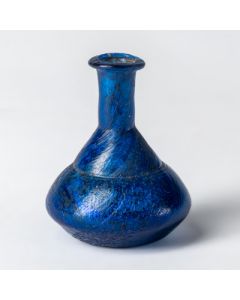 Roman ointment bottle of bright blue glass
Roman ointment bottle of bright blue glassA strikingly colourful bottle for oil or perfume. From the Roman Imperial period, made in a province of the eastern Mediterranean.
Price: on request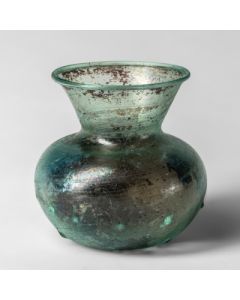 Roman glass vessel with knobs
Roman glass vessel with knobsA rare and impressive vessel type from a late Roman glass factory in the Levant. Dating from the 3rd to 4th century.
Price: on request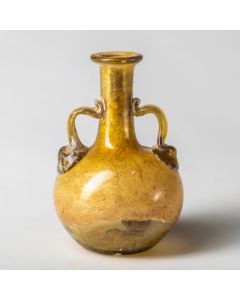 Roman glass bottle with handles
Roman glass bottle with handlesThe glass impresses with its elegant shape. Made in one of the Roman glass factories in the eastern Mediterranean during the Late Imperial period.
Price: on request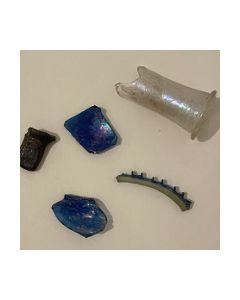 Ancient glass fragments
Ancient glass fragmentsRoman glass shards from the 1st to 4th centuries. Professor Manegold Collection.
Price: on request Roman square glass bottle
Roman square glass bottleTypical and popular glass vessel type from the Roman Imperial period. From the Heckmann collection.
Price: on request Roman glass bowl
Roman glass bowlSmall bowl made of pale turquoise glass, from the Roman Imperial period. Acquired in 1974 at the antiquities gallery Neuhaus.
Price: on request Three ancient pottery vessels
Three ancient pottery vesselsAn exciting mixed group from the Iron Age to Classical Antiquity. From the collection of Professor Manegold.
Price: on request Two cypriot juglets
Two cypriot jugletsSo-called Bilbil jugs of the Base Ring I ware. A testament to the opium trade of the late Bronze Age.
Price: on request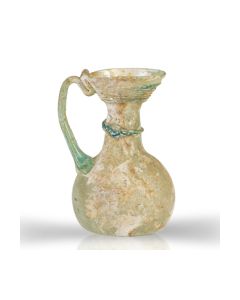 Roman glass pitcher
Roman glass pitcherFine and beautifully decorated glass pitcher from Roman Palestine, probably from an ancient workshop in what is now Jalamah. Around 500 AD.
Price: on request Roman glass bowl
Roman glass bowlSmall bowl made of pale turquoise glass, from the Roman Imperial period. From the Heckmann collection.
Price: on request Roman glass jug with handle
Roman glass jug with handleA fine glass vessel from the 1st to 2nd century. Made in the eastern Mediterranean.
Price: on request Roman globular glass bottle
Roman globular glass bottleBeautifully decorated with bands of incised decorative grooves. Spherical body and funnel-shaped neck.
Price: on request Roman glass bowl
Roman glass bowlThe nice and small bowl is made of thick-walled glass. Possibly an Eastern Mediterranean made vessel.
Price: on request Roman glass flask
Roman glass flaskThe large ancient glass, a so-called unguentarium for perfume or precious oil, comes from the eastern Mediterranean, probably from Syria. Acquired in 1974 from art dealer Albrecht Neuhaus.
Price: on request Roman blue glass bowl
Roman blue glass bowlThe small storage vessel impresses with its beautiful cobalt blue colour. It was made in the 1st century, probably in Italy.
Price: on request Roman sprinkler
Roman sprinklerPerfume bottle with pattern-blown body. An aperture made it easy to dispense the precious content drop by drop. Made in the Roman province Syria in the 3rd cent. AD.
Price: on request Two Roman glass unguentaria
Two Roman glass unguentariaThe early imperial perfume bottles are from the eastern Mediterranean. Acquired in 1974 from art dealer Albrecht Neuhaus.
Price: on request Roman ribbed glass bowl
Roman ribbed glass bowlOf beautiful, thick-walled glass of a bright light green color. The glass was mold made in a Roman factory of the eastern Mediterranean.
Price: on request Roman jug made of aubergine glass
Roman jug made of aubergine glassBeautiful glass with a violet colour. From the Roman Imperial period.
Price: on request Roman glass beaker
Roman glass beakerRare cup made of almost colourless glass. A 4th century product from the eastern Mediterranean.
Price: on request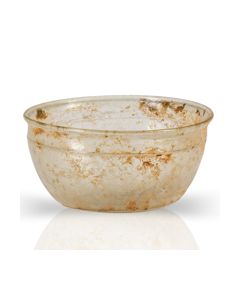 Small Roman glass bowl
Small Roman glass bowlSmall bowl made of colourless glass, from the Roman Imperial period. The shape imitates metal vessels.
Price: on request Roman glass bottle with handle
Roman glass bottle with handleThe cylindrical vessel has a nice iridescent patina. Made between 50 and 200 AD on the Black Sea coast or in the Near East.
Price: on request Late Roman glass flask
Late Roman glass flaskFlat bottle with double handle from the Eastern Mediterranean. Made between the 3rd and 6th century.
Price: on request Glass bottle with nub decoration
Glass bottle with nub decorationThe pear-shaped glass comes from the late Roman or early Byzantine period. Presumably from the Eastern Roman province of Palaestina.
Price: on request Roman glass juglet
Roman glass jugletThe small jug with a pear-shaped body is outstanding due to the strongly iridescent patina and the dark coating on the outside. From the Late Roman Imperial period.
Price: on request Elamite horse rhyton
Elamite horse rhytonFascinating clay vessel in the shape of a horse from the Neo-Elamite period, around 700 BC. A TL analysis report is included with the piece.
Price: on request Square bottle of thick glass
Square bottle of thick glassSmall ancient glass flask, like they are found along the old trade routes of the Islamic world. Such bottles were used around 1000 years ago to transport precious oils and other liquids.
Price: on request Mesopotamian stone vessel
Mesopotamian stone vesselHeavy and high quality vessel from Bronze Age of Mesopotamia, reminescent of similar Egyptian stone vessels. Ex Christie's.
Price: on request Victorian ink bottle
Victorian ink bottleThe vessel is made of beautiful, turquoise glass. From the collection of Moshe Dayan.
Price: on request Roman lentoid glass flask
Roman lentoid glass flaskThe flat bottle has a discoid body with a very long neck. Probably from the Roman province Judaea.
Price: on request Roman glass bottle with handle
Roman glass bottle with handleNice and relatively large bottle from the late Roman imperial period. Probably from the Roman province Judaea.
Price: on request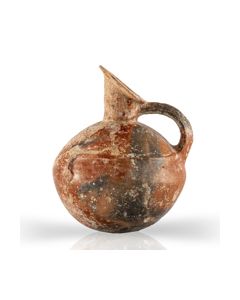 Spouted jug of the Yortan culture
Spouted jug of the Yortan cultureThe large jug has a spherical body, decorated with two stylized arms and hands. From Bronze Age Anatolia.
Price: on request Painted Bronze Age jug
Painted Bronze Age jugThe clay jug is decorated by an impressively well preserved geometric design. From Bronze Age Anatolia.
Price: on request Anatolian clay pot with lid
Anatolian clay pot with lidThe Bronze Age vessel rests on three legs and has a lid with a conical handle. Circa 2500 to 2000 BC.
Price: on request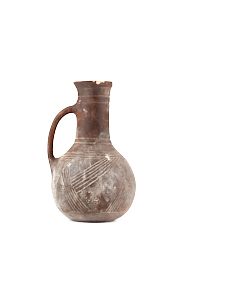 Anatolian clay jug with incised decoration
Anatolian clay jug with incised decorationThe Bronze Age vessel has wonderful linear decorative bands, the white filling of which contrasts with the dark slip. Circa 2500 to 2000 BC.
Price: on request Roman lentoid glass flask
Roman lentoid glass flaskThe flat bottle has a lentoid or discoid body with a long neck. Probably from the Roman province Judaea.
Price: on request

